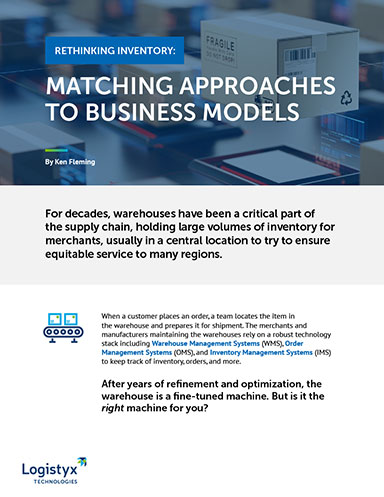Rethinking Inventory to Match Business Models and Needs
As changing consumer behaviors and expectations, shorter product lifecycles, and supply chain disruptions become more frequent and persistent, businesses should closely examine their approach to inventory and regularly evaluate whether it matches their business model and current needs.
For decades, warehouses have been a critical part of the supply chain, holding large volumes of inventory for merchants, usually in a central location to try to ensure equitable service to many regions.
When a customer places an order, a team locates the item in the warehouse and prepares it for shipment.
The merchants and manufacturers maintaining the warehouses rely on a robust technology stack including Warehouse Management Systems (WMS), Order Management Systems (OMS), and Inventory Management Systems (IMS) to keep track of inventory, orders, and more.
After years of refinement and optimization, the warehouse is a fine-tuned machine. But is it the right machine for you?
Log in to download this paper.
What’s Related
Related Companies
Logistyx Technologies
Related Topics
Inventory Management
EcommerceInventory ManagementLogistyx TechnologiesOrder FulfillmentOrder Management SystemRisk ManagementSupply ChainSupply Chain DisruptionWarehouse Management System
All topics
News





Why Peak Season Planning Needs to be a Year-Round Endeavor
Order fulfillment and logistics teams should be looking at peak season planning year-round to keep their operations prepared.
E2open Acquires Global Multi-Carrier Ecommerce Shipping Software Platform Logistyx Technol...
Time to Plan for the 12-Month Peak Season
How Parcel Shippers can Put Technology to Work to Gain Competitive Advantage
Multi-Carrier Parcel Shipping Systems - Use Cases, Advantages, and Strategies
More News
Resources

Embracing the Cross-Border E-Commerce Opportunity
An e2open research report exploring the growth of cross-border e-commerce through consumers’ eyes.

Optimize Your Parcel Shipping Strategy
New Parcel shipping software helps you manage the entire process for shipping.

7 Logistics Trends that will Radically Change the Shipping Landscape in 2022
Increasing customer demands, unprecedented cargo logjams, workforce shortages, carrier capacity constraints, and the lasting effects of the pandemic have made supply chains more vo...
More Resources
Favorites

How Does IKEA’s Inventory Management Supply Chain Strategy Really Work?
Each IKEA store is huge and holds more than 9,500 products! How in the world does IKEA offer so...

Starbucks as an Example of the Value Chain Model
The concept of value chain helps to understand and segregate the useful (which help in gaining a competitive...

7 Principles of Supply Chain Management Explained
Would you like to understand supply chain management concepts but don't have time to study from a textbook?...

Is Apple’s Supply Chain Really the No. 1? A Case Study
How Complex is Apple's Supply Chain? Some people in the blogosphere said that Apple's Supply Chain is not...

